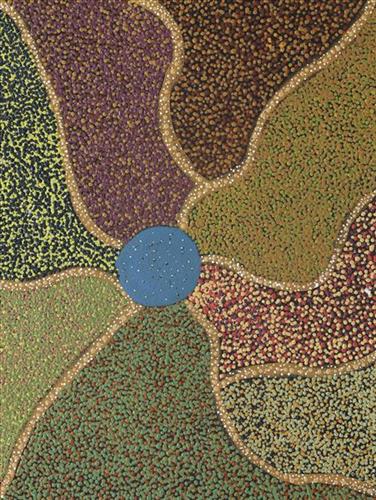Biography:
“I was born in Strelley and, yeah, we was there until we come to Punmu when I was, might be, 3,4, 5 years old. I grew up here in Punmu, go to school here. First we was at Yilyara [one of several frequently visited yinta (permanent springs) located in the Country immediately surrounding Punmu Aboriginal community] There was two house there then. I was all the time living with my mum, Mulyatingki [Marney].
When I was maybe 11 we was staying at Bidyadanga [a community located on the Kimberley coast in Western Australia] for a little while- me and Mulyatingki. She had a brother there, but he passed away. My big sister, Morag Chapman, she had a husband in Bidyadanga too. Mulyatingki, she didn’t want to stay there in Bidyadanga, she wanted to come back to Punmu, so we came back. I lived in Punmu until I had kids and moved to Kalgoorlie, moved to Jameson Range.
I was painting before, when the old people was alive, ngaru (poor things), when they first started painting [in 2006, when Martumili Artists was established]. I was helping my mum when I was going to school. When they [the artists] first started, I was sitting down and helping mum a little bit. I was doing it because my mother paint, paint, always doing painting, and I just do it too. Mulyatingki told me to paint, and the old girl [Mulyatingki’s younger sister] too.
I didn’t paint again until I came back to Punmu. But I’m happy here! Happy because my kids are here. I was too long away, in Kalgoorlie, and I feel homesick- I want to come back to Punmu and do a bit of painting. And my mum and brother were too sick, I come back to be with them.
I paint about my Country, all around Punmu, and my mum’s Country. Mulyatingki told me about how to do [paint] her country, Nyinyiri Country, where she born. I never been there, I have to go there one day. Mum told me in the Martu way, how she talk, she told me to do all the warla (lake, claypan), sandhills and waterholes. She told me do that. I get an idea from mum, she tell me and I think and I paint it. I see her painting, what she do, and when I come back home I think in my mind how she do. I’m proud of her and I’m proud of painting where I grew up.
Here in Punmu I paint with other people now, Gladys [Bidu] and Yikartu [Bumba]. We have a story and a laugh. It’s good, and making me happy. [When I paint] I just do what I like to do. I see the colours coming in the sandhill- I do it red, I do it brown. Sandhill and spinifex and lake and all the flowers and trees all mixed.
Gladys and Yikartu, they tell me, talk to me about painting. The old girl [Mulyatingki’s youngest sister], she would tell me and mum tell me too. One day when mum comes I’ll sit with her and paint- I might get a different idea! My daughter [Shasharnie Lane] and son [Otis Lane] paint now too.
I just done another painting, ‘Jila Jila rockhole’. I done it a bit different. I was looking at the colours on the sand and the rock when the sun was going down. I’m learning.
[Besides painting] I like to make baskets. I learned by my mum and my sister Morag too. I been learn by them when I was a bit younger, might be about twenty years old. Now I’m fourty four and I can do really good, big baskets.
I also like to go hunting too, and I like to sing a Martu song for the kids here in Punmu. I was singing at the school for the little jijis (children), singing the songs. I help the jijis with KJ [Martu organisation ‘Kanyirninpa Jukurrpa’ runs a ‘Family’ program in addition to Social, Culture and Country programs. Collectively these Martu led programs work to “teach young people about their culture and look after country.”]
- Dianne Marney
Diane Marney, daughter of the renowned artist Mulyatingki Marney, first learned to paint and weave baskets alongside her mother and aunt during the early days of the Martumili Artists, nearly twenty years ago. After spending many years in the Kalgoorlie region as a young woman, Diane has recently returned to both her artistic roots and her home Country, Punmu.




